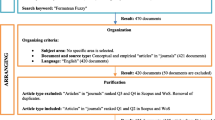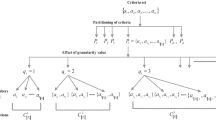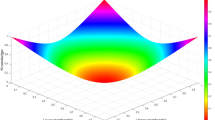Abstract
The Maclaurin symmetric mean (MSM) and dual Maclaurin symmetric mean (DMSM) operators are two aggregation operators to aggregate the cubic Pythagorean linguistic fuzzy number. The cubic Pythagorean linguistic fuzzy structure is more real to designate fuzzy data in real decision-making problems. The cubic Pythagorean linguistic fuzzy number is more superior and difficult information in the environment of the fuzzy set theory. We describe the score and accuracy function of CPLFN. We define some aggregation operators, including the CPLFAA, CGPLFAA, CPLFGA, CPLFMSM, and CPLFWMSM operators. We present some operators, with the CPLFDWMSMA, CPLFDOWMSMA, CPLFDHWMSMA, CPLFDWMSMG, CPLFDOWMSMG and CPLFDHWMSMG operators. Moreover, some properties and special cases of our proposed methods are also introduced. Then we present multi-attributive group decision-making based on proposed methods. Further, a numerical example is provided to illustrate the flexibility and accuracy of the proposed operators. Last, the proposed methods are compared with existing methods to examine the best developing skill initiatives.








Similar content being viewed by others
References
Ahmadzade H, Gao R (2020) Covariance of uncertain random variables and its application to portfolio optimization. J Ambient Intell Humaniz Comput 11:2613–2624
Alafeef M, Fraiwan M, Alkhalaf H, Audat Z (2020) Shannon entropy and fuzzy C-means weighting for AI-based diagnosis of vertebral column diseases. J Ambient Intell Humaniz Comput 11:2557–2566
Atanassov KT, Gargov G (1989) Interval-valued intuitionistic fuzzy sets. Fuzzy Set Syst 31(3):343–349
Beg I, Rashid T (2016) An intuitionistic 2-tuple linguistic information model and aggregation operators. Int J Intell Syst 31(6):569–592
Chen Z, Liu P, Pei Z (2015) An approach to multiple attribute group decision making based on linguistic intuitionistic fuzzy numbers. Int J Comput Intell Syst 8(4):747–760
Chen CT, Huang SF, Hung WZ (2018) Linguistic VIKOR method for project evaluation of ambient intelligence product. J Ambient Intell Humaniz Comput. https://doi.org/10.1007/s12652-018-0889-x
Du Y, Hou F, Zafar W, Yu Q, Zhai Y (2017) A novel method for multiattribute decision making with interval-valued Pythagorean fuzzy linguistic information. Int J Intell Syst 32(10):1085–1112
Garg H (2000) New ranking method for normal intuitionistic sets under crisp, interval environments and its applications to multiple attribute decision making process. Complex Intell Syst. https://doi.org/10.1007/s40747-020-00150-7
Garg H (2016a) A novel correlation coefficients between Pythagorean fuzzy sets and its applications to decision-making processes. Int J Intell Syst 31(12):1234–1252
Garg H (2016b) A new generalized Pythagorean fuzzy information aggregation using Einstein operations and its application to decision making. Int J Intell Syst 31(9):886–920
Garg H (2017a) Confidence levels based Pythagorean fuzzy aggregation operators and its application to decision-making process. Comput Math Organ Theory 23(4):546–571
Garg H (2017b) Generalized Pythagorean fuzzy geometric aggregation operators using Einstein t-norm and t-conorm for multicriteria decision-making process. Int J Intell Syst 32(6):597–630
Garg H, Arora R (2020) Maclaurin symmetric mean aggregation operators based on t-norm operations for the dual hesitant fuzzy soft set. J Ambient Intell Humaniz Comput 11(1):375–410
Gou X, Xu Z, Ren P (2016) The properties of continuous Pythagorean fuzzy information. Int J Intell Syst 31(5):401–424
Herrera F, Martinez L (2000) An approach for combining linguistic and numerical information based on the 2-tuple fuzzy linguistic representation model in decision-making. Int J Uncertain Fuzziness Knowl Based Syst 8(05):539–562
Herrera F, Martínez L (2000) A 2-tuple fuzzy linguistic representation model for computing with words. IEEE Trans Fuzzy Syst 8(6):746–752
Jana C, Pal M, Wang JQ (2018) Bipolar fuzzy Dombi aggregation operators and its application in multiple-attribute decisionmaking process. J Ambient Intell Hum Comput. https://doi.org/10.1007/s12652-018-1076-9
Jin CX, Li FC, Zhang K, Xu LD, Chen Y (2020) A cooperative effect-based decision support model for team formation. Enterp Inf Syst 14(1):110–132
Ju Y, Liu X, Ju D (2016) Some new intuitionistic linguistic aggregation operators based on Maclaurin symmetric mean and their applications to multiple attribute group decision making. Soft Comput 20(11):4521–4548
Jun YB, Ahn SS (2016) Hesitant fuzzy set theory applied to BCK/BCI-algebras. J Comput Anal Appl 20(4):635–646
Lei F, Lu J, Wei G, Wu J, Wei C, Guo Y (2000) GRA method for waste incineration plants location problem with probabilistic linguistic multiple attribute group decision making. J Intell Fuzzy Syst. https://doi.org/10.3233/JIFS-191443
Liang W, Zhang X, Liu M (2015) The maximizing deviation method based on interval-valued Pythagorean fuzzy weighted aggregating operator for multiple criteria group decision analysis. Discr Dyn Nat Soc. https://doi.org/10.1155/2015/746572
Li D, Zeng W (2018) Distance measure of Pythagorean fuzzy sets. Int J Intell Syst 33(2):348–361
Liu P, Jin F (2012) Methods for aggregating intuitionistic uncertain linguistic variables and their application to group decision making. Inf Sci 205:58–71
Liu P (2013) Some geometric aggregation operators based on interval intuitionistic uncertain linguistic variables and their application to group decision making. Appl Math Model 37(4):2430–2444
Liu P, Wang Y (2014) Multiple attribute group decision making methods based on intuitionistic linguistic power generalized aggregation operators. Appl Soft Comput 17:90–104
Liu P, Rong L, Chu Y, Li Y (2014) Intuitionistic linguistic weighted Bonferroni mean operator and its application to multiple attribute decision making. Sci World J. https://doi.org/10.1155/2014/545049
Liu P, Li D (2017) Some Muirhead mean operators for intuitionistic fuzzy numbers and their applications to group decision making. PLoS One 12(1):e0168767
Liu P, Wang P (2017) Some improved linguistic intuitionistic fuzzy aggregation operators and their applications to multiple-attribute decision making. Int J Inf Technol Decis Making 6(03):817–850
Liu C, Tang G, Liu P (2017a) An approach to multicriteria group decision-making with unknown weight information based on Pythagorean fuzzy uncertain linguistic aggregation operators. Math Problems Eng. https://doi.org/10.1155/2017/6414020
Liu J, Wu X, Zeng S, Pan T (2017b) Intuitionistic linguistic multiple attribute decision-making with induced aggregation operator and its application to low carbon supplier selection. Int J Environ Res Public Health 14(12):1451
Liu Y, Qin Y, Han Y (2018) Multiple criteria decision making with probabilities in interval-valued Pythagorean fuzzy setting. Int J Fuzzy Syst 20(2):558–571
Ma Z, Xu Z (2016) Symmetric Pythagorean fuzzy weighted geometric/averaging operators and their application in multicriteria decision-making problems. Int J Intell Syst 31(12):1198–1219
Merigo JM, Casanovas M, Martínez L (2010) Linguistic aggregation operators for linguistic decision making based on the Dempster-Shafer theory of evidence. Int J Uncertain Fuzziness Knowl Based Syst 18(03):287–304
Merigo JM, Casanovas M (2010) Decision making with distance measures and linguistic aggregation operators. Int J Fuzzy Syst 12(3):190–198
Muirhead RF (2009) Some methods applicable to identities and inequalities of symmetric algebraic functions of n letters. Proc Edinburgh Math Soc 21:144–162
Peng X, Yang Y (2015) Some results for Pythagorean fuzzy sets. Int J Intell Syst 30(11):1133–1160
Peng X, Yang Y (2016a) Fundamental properties of interval-valued Pythagorean fuzzy aggregation operators. Int J Intell Syst 31(5):444–487
Peng X, Yuan H (2016) Fundamental properties of Pythagorean fuzzy aggregation operators. Fundamenta Informaticae 147(4):415–446
Peng X, Yang Y (2016b) Pythagorean fuzzy Choquet integral based MABAC method for multiple attribute group decision making. Int J Intell Syst 31(10):989–1020
Peng XD, Yang Y (2016) Multiple attribute group decision making methods based on Pythagorean fuzzy linguistic set. Comput Eng Appl 52(23):50–54
Peng X, Dai J (2017) Approaches to Pythagorean fuzzy stochastic multi-criteria decision making based on prospect theory and regret theory with new distance measure and score function. Int J Intell Syst 32(11):1187–1214
Peng X, Yuan H, Yang Y (2017) Pythagorean fuzzy information measures and their applications. Int J Intell Syst 32(10):991–1029
Qin J, Liu X (2014) An approach to intuitionistic fuzzy multiple attribute decision making based on Maclaurin symmetric mean operators. J Intell Fuzzy Syst 27(5):2177–2190
Qin J, Liu X (2016) 2-tuple linguistic Muirhead mean operators for multiple attribute group decision making and its application to supplier selection. Kybernetes 45(1):2–29
Rani P, Mishra AR, Mardani A (2020) An extended Pythagorean fuzzy complex proportional assessment approach with new entropy and score function: application in pharmacological therapy selection for type 2 diabetes. Appl Soft Comput 94:106441
Ren P, Xu Z, Gou X (2016) Pythagorean fuzzy TODIM approach to multi-criteria decision making. Appl Soft Comput 42:246–259
Shoba S, Rajavel R (2020) A new Genetic Algorithm based fusion scheme in monaural CASA system to improve the performance of the speech. J Ambient Intell Humaniz Comput 11(1):433–446
Thao NX, Smarandache F (2000) Apply new entropy based similarity measures of single valued neutrosophic sets to select supplier material. J Intell Fuzzy Syst 39(1):1005–1019
Ulla K, Garg H, Mahmood T, Jan N, Ali Z (2020) Correlation coefficients for T-spherical fuzzy sets and their applications in clustering and multi-attribute decision making. Soft Comput 24(3):1647–1659
Wang JQ, Li JJ (2009) The multi-criteria group decision making method based on multi-granularity intuitionistic two semantics. Sci Technol Inf 33:8–9
Wan SP, Jin Z, Dong JY (2018) Pythagorean fuzzy mathematical programming method for multi-attribute group decision making with Pythagorean fuzzy truth degrees. Knowl Inf Syst 55(2):437–466
Wei G, Lu M (2018) Pythagorean fuzzy Maclaurin symmetric mean operators in multiple attribute decision making. Int J Intell Syst 33(5):1043–1070
Xu LD (1990) Linguistic approach to the multi-criteria ranking problem. Int J Syst Sci 21(9):1773–1782
Xu Z (2004) Uncertain linguistic aggregation operators based approach to multiple attribute group decision making under uncertain linguistic environment. Inf Sci 168(1–4):171–184
Xu L, Cai L, Zhao S, Ge B (2016) Inaugural issue editorial. J Ind Inf Integr 1:1–2
Yager RR (2013) Pythagorean membership grades in multicriteria decision making. IEEE Trans Fuzzy Syst 22(4):958–965
Yager RR, Abbasov AM (2013) Pythagorean membership grades, complex numbers, and decision making. Int J Intell Syst 28(5):436–452
Zhang H (2014) Linguistic intuitionistic fuzzy sets and application in MAGDM. J Appl Math. https://doi.org/10.1155/2014/432092
Zhang X, Xu Z (2014) Extension of TOPSIS to multiple criteria decision making with Pythagorean fuzzy sets. Int J Intell Syst 29(12):1061–1078
Zhang X (2016a) A novel approach based on similarity measure for Pythagorean fuzzy multiple criteria group decision making. Int J Intell Syst 31(6):593–611
Zhang X (2016b) Multicriteria Pythagorean fuzzy decision analysis: a hierarchical QUALIFLEX approach with the closeness index-based ranking methods. Inf Sci 330:104–124
Zhang HY, Peng HG, Wang J, Wang JQ (2017) An extended outranking approach for multi-criteria decision-making problems with linguistic intuitionistic fuzzy numbers. Appl Soft Comput 59:462–474
Zeng S, Chen J, Li X (2016) A hybrid method for Pythagorean fuzzy multiple-criteria decision making. Int J Inf Technol Decis Mak 15(02):403–422
Acknowledgements
The authors extend their appreciation to the Deanship of Scientific Research at Majmaah University for funding this work under Project Number no. RGP-2019-5.
Funding
This study is supported by Deanship of Scientiic Research at Majmaah University under Project Number no. RGP-2019-5.
Author information
Authors and Affiliations
Corresponding author
Ethics declarations
Conflict of interest
The authors declare that there is no conflict of interests regarding the publication of this paper
Ethical approval
This article does not contain any studies with human participants or animals performed by any of the authors.
Additional information
Publisher's Note
Springer Nature remains neutral with regard to jurisdictional claims in published maps and institutional affiliations.
Rights and permissions
About this article
Cite this article
Fahmi, A., Yaqoob, N. & Chammam, W. Maclaurin symmetric mean aggregation operators based on cubic Pythagorean linguistic fuzzy number. J Ambient Intell Human Comput 12, 1925–1942 (2021). https://doi.org/10.1007/s12652-020-02272-9
Received:
Accepted:
Published:
Issue Date:
DOI: https://doi.org/10.1007/s12652-020-02272-9




